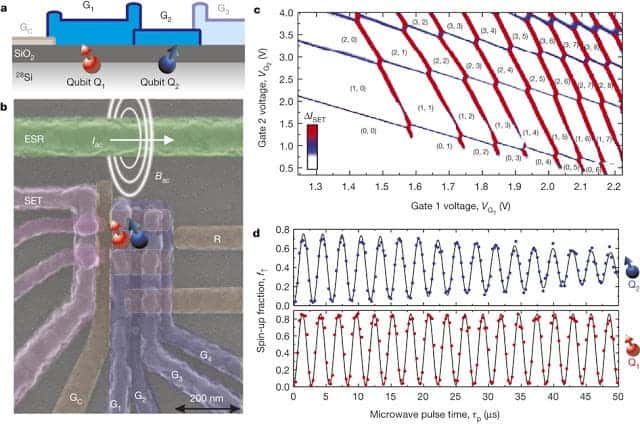Quantum computing is one of the future’s transitional technologies destined to transform human society, along with advanced materials like graphene and metallic glass or advances in space propulsion. Imagine what the transition from vacuum tubes to transistors did for computing, scale that a couple of folds and you might somewhat be close to what quantum computers are capable of. Operations that today’s supercomputers require days even weeks to crunch, would be completed immediately by leveraging the quantum weirdness that happens below the nano scale. All of this is theoretically possible – but in practice building a working quantum computer that doesn’t disintegrate information has proven to be an immense challenge. We’re still far from there, but advances reported by Australian researchers hint that quantum computers aren’t a pipe dream.

The researchers from the Australian National Fabrication Facility at the University of New South Wales devised a working two-qubit logic gate all on silicon, the main building block used for the billions of transistors that litter any smartphone.
First, let’s recap. Transistors perform logic operations by shuttling bits of data, each assigned a value which is either “0” or “1”. That’s how a classical, digital computer works. Quantum computers, however, use qubits or a quantum bit which can simultaneously exist in both states at once – both “0” and “1”. This is known as a superposition, and if scientists can leverage it then information could be processed in parallel. Two-qubits can perform operations on four values, three on eight values and so on in powers of two. Today’s computers have millions of transistors. Now imagine a quantum logic gate that works with millions of qubits. The computing force would be unheard of.
Up until now, no one was able to make two qubits talk to each other using a silicon chip. Some attempts proved successful, but using exotic methods and materials. Crafting quantum logic gates with silicon is essential, since the this the de facto material of choice in any major semiconductor application. You want to exploit the existing mammoth infrastructure, not start from scratch. Quantum computers need not be electric cars.

What they did – and sorry if I’m sketchy on the details, but I couldn’t find/understand more – was basically re-purpose transistors used in classic silicon chips so these could ‘talk’ qubits. “We’ve morphed those silicon transistors into quantum bits by ensuring that each has only one electron associated with it. We then store the binary code of 0 or 1 on the ‘spin’ of the electron, which is associated with the electron’s tiny magnetic field,” said Professor Mark Hoffman, UNSW’s Dean of Engineering.
Hoffman says they’ve been granted a patent for their design, which theoretically could be scaled to run operation with million of qubits.
“What we have is a game changer,” said team leader Andrew Dzurak, Scientia Professor and Director of the Australian National Fabrication Facility at UNSW.
“We’ve demonstrated a two-qubit logic gate – the central building block of a quantum computer – and, significantly, done it in silicon. Because we use essentially the same device technology as existing computer chips, we believe it will be much easier to manufacture a full-scale processor chip than for any of the leading designs, which rely on more exotic technologies.
“This makes the building of a quantum computer much more feasible, since it is based on the same manufacturing technology as today’s computer industry,” he added.
“Once one can build a quantum computer that outperforms a supercomputer, then you’re in that realm of being able to crack crypto code,” Dzurak said. “I think it’s a good decade and a half before that’s available; that will probably make a lot of people breathe easier for now.”
Dzurak says they’re about five years away from building a working qubit processor.
“The advances with this new type of qubit — this CMOS compatable qubit — has been incredibly quick. We demonstrated the first operation of one of these only one year ago, and already we’ve gone to two qubits which is very, very fast compared to all of the other implementations around the world,” he said.
“In fact we’ve already got a device that is already operating three qubits. It’s a very straightforward way of chaining up these transistors, but scaling up to tens or hundreds of quantum bits can really only be done in partnership with industry.”
The work was reported in the journal Nature.


